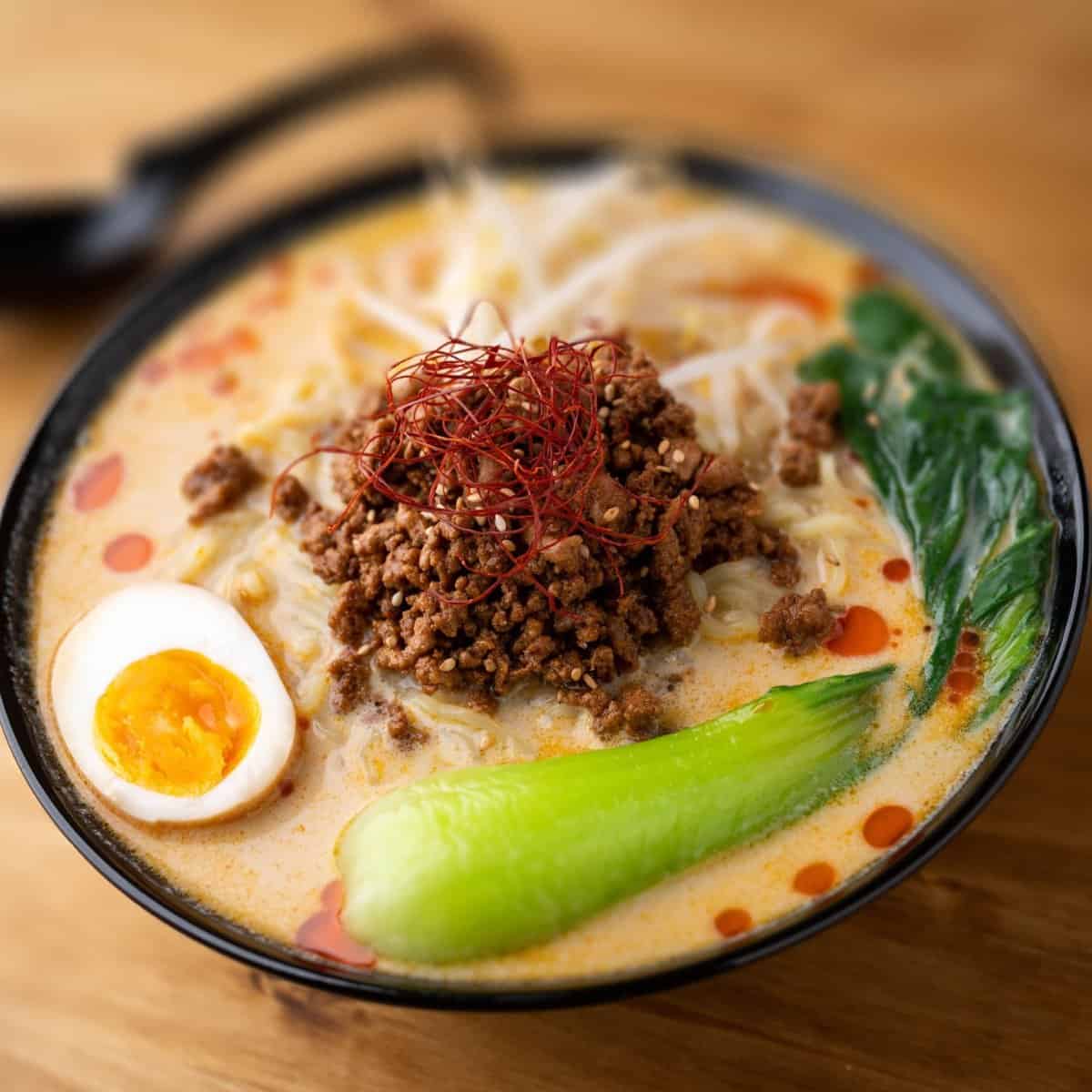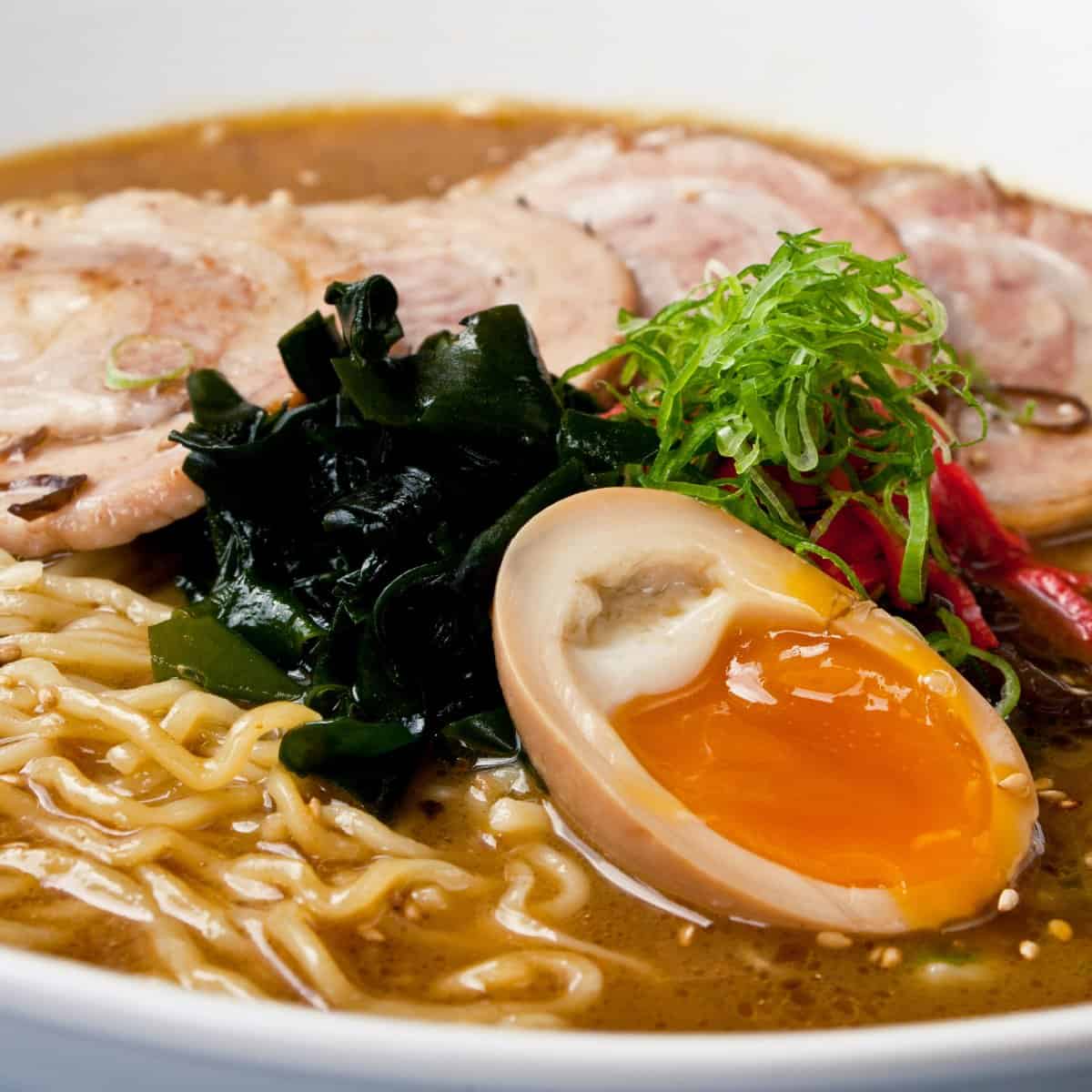Tan Tan Ramen VS Tonkotsu: A Showdown of 2 Delicious Ramen Styles
Have you ever wondered what the difference is between tan tan ramen or “Tantanmen” and tonkotsu? If so, you’re in the right place.
Tan Tan Ramen is a spicy Sichuan-style ramen with curly noodles in a chili-based broth, while Tonkotsu has a creamy pork-based broth with straight and thin noodles. Tan Tan Ramen is usually spicier with a more robust texture. The sesame paste and chili oil give it a bold, spicy flavor.
In this blog post, we’ll be doing a taste test of these two popular ramen styles to help you decide which one is right for you.


Check out our new cookbook
Bitemybun's family recipes with complete meal planner and recipe guide.
Try it out for free with Kindle Unlimited:
Read for freeIn this post we'll cover:
Tan tan ramen vs tonkotsu
Tan Tan Ramen is a type of ramen that originated in China and is now popular in Japan. It is characterized by its spicy sesame-based broth, minced pork, and thick, curly noodles.
The broth is made with a combination of sesame paste, chili oil, and soy sauce, giving it a rich and spicy flavor.
The minced pork is added to the broth and cooked until it is tender and flavorful. The thick, curly noodles are cooked separately and added to the broth before serving.
Tonkotsu is a type of ramen that originated in Japan and is now popular worldwide. It is characterized by its creamy pork-based broth, slices of pork, and thin, straight noodles.
The broth is made by boiling pork bones for several hours, resulting in a thick, creamy, and flavorful broth.
The pork slices are added to the broth and cooked until they are tender and flavorful. The thin, straight noodles are cooked separately and added to the broth before serving.
Tan Tan Ramen is usually spicier than Tonkotsu and has a more robust texture. The sesame paste and chili oil give it a bold, spicy flavor, while the thick, curly noodles add a hearty texture.
Tonkotsu, on the other hand, has a smoother, creamier texture. The pork bones give it a rich and flavorful broth, while the thin, straight noodles add a light and delicate texture.
Taste
Tan Tan Ramen and Tonkotsu Ramen have different flavor profiles. Tan Tan Ramen has a spicy, savory flavor with a hint of sweetness, while Tonkotsu Ramen has a creamy, rich flavor with a hint of porkiness. Tan Tan Ramen is usually served with a spicy chili oil, while Tonkotsu Ramen is usually served with a creamy, pork-based broth.
Texture
Tan Tan Ramen has a chewy texture, while Tonkotsu Ramen has a softer, more velvety texture. Tan Tan Ramen is usually served with a thicker noodle (here are even more types of noodles), while Tonkotsu Ramen is usually served with a thinner noodle.
Toppings
Tan Tan Ramen is usually served with a variety of toppings, such as pork, egg, bamboo shoots, and vegetables. Tonkotsu Ramen is usually served with a variety of toppings, such as pork, egg, seaweed, and mushrooms.
What is Tan tan ramen?
Tan Tan Ramen is a Japanese ramen dish made with a spicy sesame-based broth and topped with minced pork.
It is a popular dish in Japan and is often served with various toppings such as scallions, nori (seaweed), and pickled ginger.

The broth is boiled pork bones, vegetables, and various spices and seasonings. The pork is usually minced and cooked in broth before it is added to the noodles.
The dish is usually served with various condiments such as chili and sesame oil and soy sauce.
The chili oil gives the dish its signature spicy flavor, while the sesame oil adds a nutty flavor. The soy sauce is used to add a salty flavor to the dish.
The dish is usually served with various toppings such as scallions, nori, and pickled ginger.
The scallions provide a crunchy texture and a mild onion flavor, while the nori adds a salty and umami flavor. The pickled ginger adds sweetness and a slight sourness to the dish.
Tan Tan Ramen is a popular dish in Japan and can be found in many restaurants and ramen shops. It is a great dish to enjoy on a cold day or when looking for something spicy and flavorful.
What is tonkotsu?
Tonkotsu is Japanese ramen that has become increasingly popular in recent years. It is a pork-based broth that is made by boiling pork bones, fat, and collagen over high heat for several hours.
The resulting broth is milky, rich, and full of flavor. Tonkotsu ramen is usually served with thin, straight noodles, and topped with a variety of ingredients such as chashu (sliced pork belly), ajitama (seasoned boiled egg), menma (seasoned bamboo shoots), nori (seaweed), scallions, and kikurage (wood ear mushrooms).

The origins of tonkotsu ramen are said to be from the Hakata district of Fukuoka, Japan, where it was first served in the early 1900s.
The soup was originally made with a simple pork bone broth, but over the years, it has evolved to include other ingredients such as garlic, ginger, and soy sauce.
The broth is typically cooked for several hours, which gives it a unique, creamy texture and flavor.
Tonkotsu ramen is a popular dish in Japan and is now widely available in many countries worldwide.
It is also sometimes served with a variety of sauces, such as shoyu (soy sauce), miso (fermented soybean paste), and tare (a sweet and savory sauce).
Conclusion
In conclusion, Tan Tan Ramen and Tonkotsu are both delicious and popular Japanese soups, just of different types. Tan Tan Ramen is a spicy, savory dish with a thick, creamy broth, while Tonkotsu is a rich, milky pork broth.
Both dishes are delicious and can be enjoyed in many different ways. If you’re looking for a flavorful, comforting meal, either Tan Tan Ramen or Tonkotsu is sure to satisfy.
Check out our new cookbook
Bitemybun's family recipes with complete meal planner and recipe guide.
Try it out for free with Kindle Unlimited:
Read for freeJoost Nusselder, the founder of Bite My Bun is a content marketer, dad and loves trying out new food with Japanese food at the heart of his passion, and together with his team he's been creating in-depth blog articles since 2016 to help loyal readers with recipes and cooking tips.
